Hannaneh Hajishirzi
Shammie
Signal and Noise: A Framework for Reducing Uncertainty in Language Model Evaluation
Aug 18, 2025Abstract:Developing large language models is expensive and involves making decisions with small experiments, typically by evaluating on large, multi-task evaluation suites. In this work, we analyze specific properties which make a benchmark more reliable for such decisions, and interventions to design higher-quality evaluation benchmarks. We introduce two key metrics that show differences in current benchmarks: signal, a benchmark's ability to separate better models from worse models, and noise, a benchmark's sensitivity to random variability between training steps. We demonstrate that benchmarks with a better signal-to-noise ratio are more reliable when making decisions at small scale, and those with less noise have lower scaling law prediction error. These results suggest that improving signal or noise will lead to more useful benchmarks, so we introduce three interventions designed to directly affect signal or noise. For example, we propose that switching to a metric that has better signal and noise (e.g., perplexity rather than accuracy) leads to better reliability and improved scaling law error. We also find that filtering noisy subtasks, to improve an aggregate signal-to-noise ratio, leads to more reliable multi-task evaluations. We also find that averaging the output of a model's intermediate checkpoints to reduce noise leads to consistent improvements. We conclude by recommending that those creating new benchmarks, or selecting which existing benchmarks to use, aim for high signal and low noise. We use 30 benchmarks for these experiments, and 375 open-weight language models from 60M to 32B parameters, resulting in a new, publicly available dataset of 900K evaluation benchmark results, totaling 200M instances.
FlexOlmo: Open Language Models for Flexible Data Use
Jul 09, 2025Abstract:We introduce FlexOlmo, a new class of language models (LMs) that supports (1) distributed training without data sharing, where different model parameters are independently trained on closed datasets, and (2) data-flexible inference, where these parameters along with their associated data can be flexibly included or excluded from model inferences with no further training. FlexOlmo employs a mixture-of-experts (MoE) architecture where each expert is trained independently on closed datasets and later integrated through a new domain-informed routing without any joint training. FlexOlmo is trained on FlexMix, a corpus we curate comprising publicly available datasets alongside seven domain-specific sets, representing realistic approximations of closed sets. We evaluate models with up to 37 billion parameters (20 billion active) on 31 diverse downstream tasks. We show that a general expert trained on public data can be effectively combined with independently trained experts from other data owners, leading to an average 41% relative improvement while allowing users to opt out of certain data based on data licensing or permission requirements. Our approach also outperforms prior model merging methods by 10.1% on average and surpasses the standard MoE trained without data restrictions using the same training FLOPs. Altogether, this research presents a solution for both data owners and researchers in regulated industries with sensitive or protected data. FlexOlmo enables benefiting from closed data while respecting data owners' preferences by keeping their data local and supporting fine-grained control of data access during inference.
Generalizing Verifiable Instruction Following
Jul 03, 2025Abstract:A crucial factor for successful human and AI interaction is the ability of language models or chatbots to follow human instructions precisely. A common feature of instructions are output constraints like ``only answer with yes or no" or ``mention the word `abrakadabra' at least 3 times" that the user adds to craft a more useful answer. Even today's strongest models struggle with fulfilling such constraints. We find that most models strongly overfit on a small set of verifiable constraints from the benchmarks that test these abilities, a skill called precise instruction following, and are not able to generalize well to unseen output constraints. We introduce a new benchmark, IFBench, to evaluate precise instruction following generalization on 58 new, diverse, and challenging verifiable out-of-domain constraints. In addition, we perform an extensive analysis of how and on what data models can be trained to improve precise instruction following generalization. Specifically, we carefully design constraint verification modules and show that reinforcement learning with verifiable rewards (RLVR) significantly improves instruction following. In addition to IFBench, we release 29 additional new hand-annotated training constraints and verification functions, RLVR training prompts, and code.
SciArena: An Open Evaluation Platform for Foundation Models in Scientific Literature Tasks
Jul 01, 2025Abstract:We present SciArena, an open and collaborative platform for evaluating foundation models on scientific literature tasks. Unlike traditional benchmarks for scientific literature understanding and synthesis, SciArena engages the research community directly, following the Chatbot Arena evaluation approach of community voting on model comparisons. By leveraging collective intelligence, SciArena offers a community-driven evaluation of model performance on open-ended scientific tasks that demand literature-grounded, long-form responses. The platform currently supports 23 open-source and proprietary foundation models and has collected over 13,000 votes from trusted researchers across diverse scientific domains. We analyze the data collected so far and confirm that the submitted questions are diverse, aligned with real-world literature needs, and that participating researchers demonstrate strong self-consistency and inter-annotator agreement in their evaluations. We discuss the results and insights based on the model ranking leaderboard. To further promote research in building model-based automated evaluation systems for literature tasks, we release SciArena-Eval, a meta-evaluation benchmark based on our collected preference data. The benchmark measures the accuracy of models in judging answer quality by comparing their pairwise assessments with human votes. Our experiments highlight the benchmark's challenges and emphasize the need for more reliable automated evaluation methods.
OMEGA: Can LLMs Reason Outside the Box in Math? Evaluating Exploratory, Compositional, and Transformative Generalization
Jun 23, 2025Abstract:Recent large-scale language models (LLMs) with long Chain-of-Thought reasoning-such as DeepSeek-R1-have achieved impressive results on Olympiad-level mathematics benchmarks. However, they often rely on a narrow set of strategies and struggle with problems that require a novel way of thinking. To systematically investigate these limitations, we introduce OMEGA-Out-of-distribution Math Problems Evaluation with 3 Generalization Axes-a controlled yet diverse benchmark designed to evaluate three axes of out-of-distribution generalization, inspired by Boden's typology of creativity: (1) Exploratory-applying known problem solving skills to more complex instances within the same problem domain; (2) Compositional-combining distinct reasoning skills, previously learned in isolation, to solve novel problems that require integrating these skills in new and coherent ways; and (3) Transformative-adopting novel, often unconventional strategies by moving beyond familiar approaches to solve problems more effectively. OMEGA consists of programmatically generated training-test pairs derived from templated problem generators across geometry, number theory, algebra, combinatorics, logic, and puzzles, with solutions verified using symbolic, numerical, or graphical methods. We evaluate frontier (or top-tier) LLMs and observe sharp performance degradation as problem complexity increases. Moreover, we fine-tune the Qwen-series models across all generalization settings and observe notable improvements in exploratory generalization, while compositional generalization remains limited and transformative reasoning shows little to no improvement. By isolating and quantifying these fine-grained failures, OMEGA lays the groundwork for advancing LLMs toward genuine mathematical creativity beyond mechanical proficiency.
Infini-gram mini: Exact n-gram Search at the Internet Scale with FM-Index
Jun 13, 2025Abstract:Language models are trained mainly on massive text data from the Internet, and it becomes increasingly important to understand this data source. Exact-match search engines enable searching in large text corpora -- counting string appearances and retrieving the enclosing documents -- yet the high storage overhead hinders their application on Internet-scale data. We present Infini-gram mini, an efficient and scalable system that can make petabyte-level text corpora searchable. Based on the FM-index data structure (Ferragina and Manzini, 2000), which simultaneously indexes and compresses text, our system creates indexes with size only 44% of the corpus. Infini-gram mini greatly improves upon the best existing implementation of FM-index in terms of indexing speed (18$\times$) and memory use during both indexing (3.2$\times$ reduction) and querying (down to a negligible amount). We index 46TB of Internet text in 50 days with a single 128-core CPU node (or 19 hours if using 75 such nodes). We show one important use case of Infini-gram mini in a large-scale analysis of benchmark contamination. We find several core LM evaluation benchmarks to be heavily contaminated in Internet crawls (up to 40% in SQuAD), which could lead to overestimating the capabilities of language models if trained on such data. We host a benchmark contamination bulletin to share the contamination rate of many core and community-contributed benchmarks. We also release a web interface and an API endpoint to serve general search queries on Infini-gram mini indexes.
Spurious Rewards: Rethinking Training Signals in RLVR
Jun 12, 2025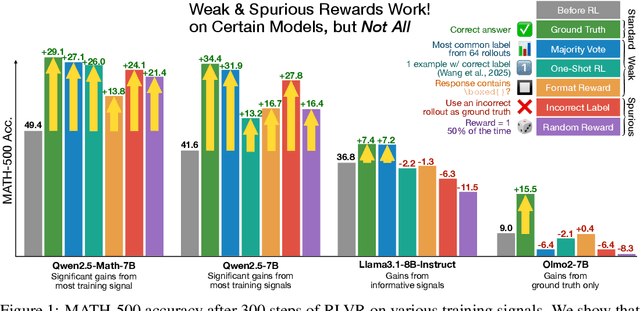


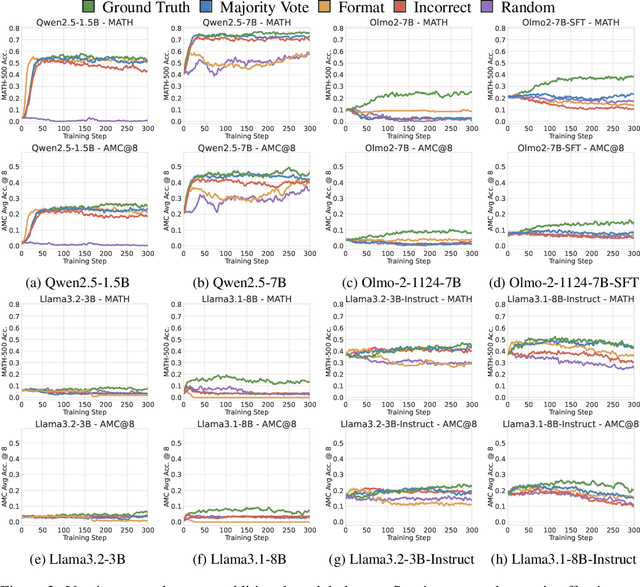
Abstract:We show that reinforcement learning with verifiable rewards (RLVR) can elicit strong mathematical reasoning in certain models even with spurious rewards that have little, no, or even negative correlation with the correct answer. For example, RLVR improves MATH-500 performance for Qwen2.5-Math-7B in absolute points by 21.4% (random reward), 13.8% (format reward), 24.1% (incorrect label), 26.0% (1-shot RL), and 27.1% (majority voting) -- nearly matching the 29.1% gained with ground truth rewards. However, the spurious rewards that work for Qwen often fail to yield gains with other model families like Llama3 or OLMo2. In particular, we find code reasoning -- thinking in code without actual code execution -- to be a distinctive Qwen2.5-Math behavior that becomes significantly more frequent after RLVR, from 65% to over 90%, even with spurious rewards. Overall, we hypothesize that, given the lack of useful reward signal, RLVR must somehow be surfacing useful reasoning representations learned during pretraining, although the exact mechanism remains a topic for future work. We suggest that future RLVR research should possibly be validated on diverse models rather than a single de facto choice, as we show that it is easy to get significant performance gains on Qwen models even with completely spurious reward signals.
ScienceMeter: Tracking Scientific Knowledge Updates in Language Models
May 30, 2025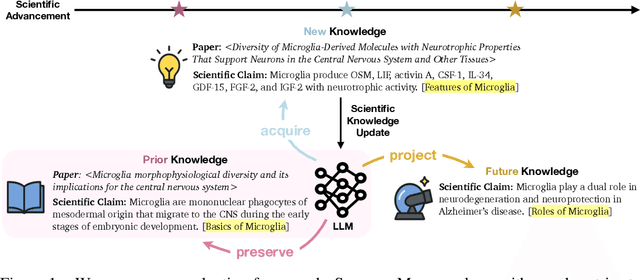
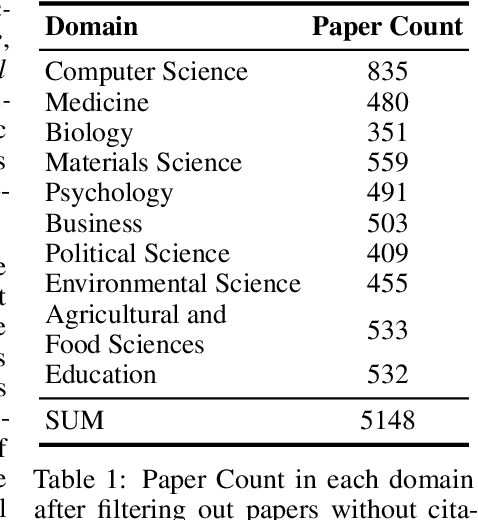
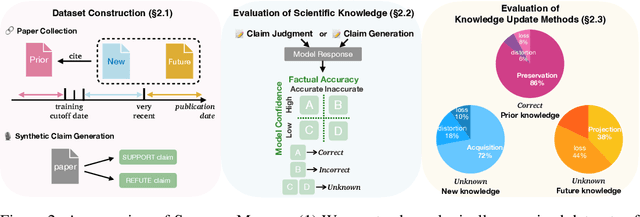
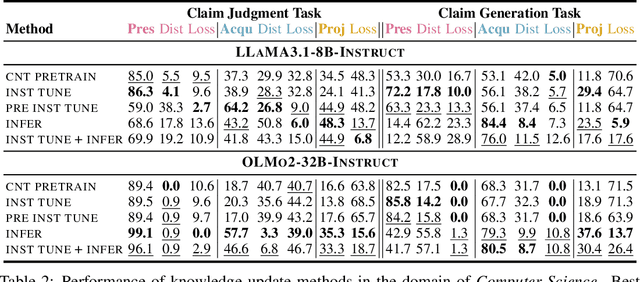
Abstract:Large Language Models (LLMs) are increasingly used to support scientific research, but their knowledge of scientific advancements can quickly become outdated. We introduce ScienceMeter, a new framework for evaluating scientific knowledge update methods over scientific knowledge spanning the past, present, and future. ScienceMeter defines three metrics: knowledge preservation, the extent to which models' understanding of previously learned papers are preserved; knowledge acquisition, how well scientific claims from newly introduced papers are acquired; and knowledge projection, the ability of the updated model to anticipate or generalize to related scientific claims that may emerge in the future. Using ScienceMeter, we examine the scientific knowledge of LLMs on claim judgment and generation tasks across a curated dataset of 15,444 scientific papers and 30,888 scientific claims from ten domains including medicine, biology, materials science, and computer science. We evaluate five representative knowledge update approaches including training- and inference-time methods. With extensive experiments, we find that the best-performing knowledge update methods can preserve only 85.9% of existing knowledge, acquire 71.7% of new knowledge, and project 37.7% of future knowledge. Inference-based methods work for larger models, whereas smaller models require training to achieve comparable performance. Cross-domain analysis reveals that performance on these objectives is correlated. Even when applying on specialized scientific LLMs, existing knowledge update methods fail to achieve these objectives collectively, underscoring that developing robust scientific knowledge update mechanisms is both crucial and challenging.
Critical Batch Size Revisited: A Simple Empirical Approach to Large-Batch Language Model Training
May 29, 2025Abstract:The right batch size is important when training language models at scale: a large batch size is necessary for fast training, but a batch size that is too large will harm token efficiency. To navigate this tradeoff, McCandlish et al. (2018) suggest that a critical batch size (CBS), below which training will not substantially degrade loss, can be estimated based on the gradient noise scale during training. While their method has been adopted in practice, e.g., when training GPT-3, strong assumptions are required to justify gradient noise as a proxy for the CBS, which makes it unclear whether their approach should be trusted in practice, limiting its applicability. In this paper, we introduce a simple, empirical approach to directly measure the CBS and show how the CBS evolves over training. Applying our approach to the OLMo models, we find that CBS is near 0 at initialization, increases rapidly at first, and then plateaus as training progresses. Furthermore, we find that this trend holds across different model sizes (1B and 7B), suggesting CBS from small training runs can inform larger-scale training runs. Our findings about how the CBS changes over training motivate batch size warmup as a natural way to reliably train language models at large batch size: start the batch size small and increase it as the CBS grows. To validate this claim, we use batch size warmup to train OLMo 1B to slightly better loss than the original training run with 43% fewer gradient steps. This shows how our framework can be applied to reliably train language models at larger batch sizes, increasing data parallelism without compromising performance.
ParaPO: Aligning Language Models to Reduce Verbatim Reproduction of Pre-training Data
Apr 20, 2025Abstract:Language models (LMs) can memorize and reproduce segments from their pretraining data verbatim even in non-adversarial settings, raising concerns about copyright, plagiarism, privacy, and creativity. We introduce Paraphrase Preference Optimization (ParaPO), a post-training method that fine-tunes LMs to reduce unintentional regurgitation while preserving their overall utility. ParaPO trains LMs to prefer paraphrased versions of memorized segments over the original verbatim content from the pretraining data. To maintain the ability to recall famous quotations when appropriate, we develop a variant of ParaPO that uses system prompts to control regurgitation behavior. In our evaluation on Llama3.1-8B, ParaPO consistently reduces regurgitation across all tested datasets (e.g., reducing the regurgitation metric from 17.3 to 12.9 in creative writing), whereas unlearning methods used in prior work to mitigate regurgitation are less effective outside their targeted unlearned domain (from 17.3 to 16.9). When applied to the instruction-tuned Tulu3-8B model, ParaPO with system prompting successfully preserves famous quotation recall while reducing unintentional regurgitation (from 8.7 to 6.3 in creative writing) when prompted not to regurgitate. In contrast, without ParaPO tuning, prompting the model not to regurgitate produces only a marginal reduction (8.7 to 8.4).
 Add to Chrome
Add to Chrome Add to Firefox
Add to Firefox Add to Edge
Add to Edge